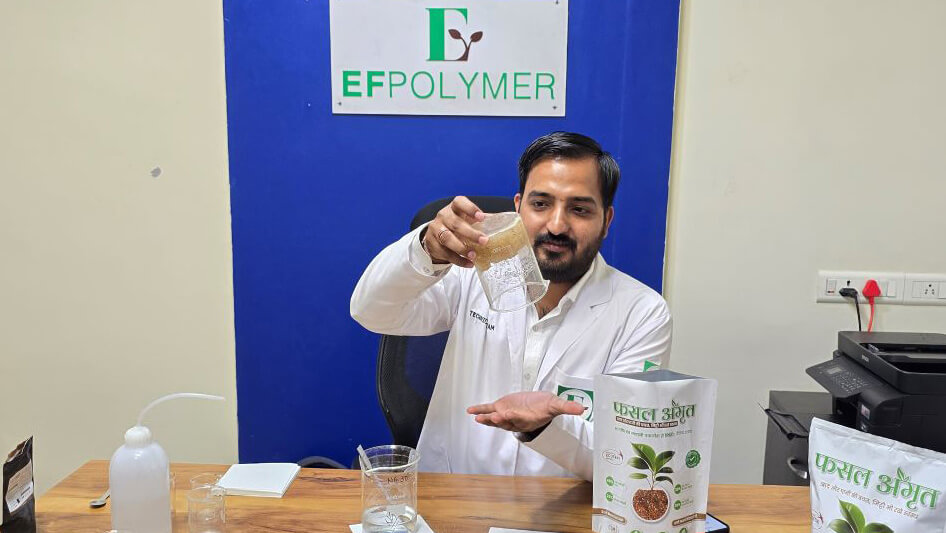Narayan Lal Gurjar is a young innovator from rural Rajasthan whose work has global impact.
 TR Vivek
TR Vivek 
Narayan Lal Gurjar is a young innovator from rural Rajasthan whose work has global impact.
 TR Vivek
TR Vivek
The story of twenty-five -year-old Narayan Lal Gurjar might not be out of place in Bollywood.
The playful experiments he conducted in his father’s small farm as a teenager in Kerdi, a village of 300 with 40 homes in Rajsamand district in southern Rajasthan, is the foundation for his patents and the agriscience startup incubated by Okinawa Institute of Science and Technology (OIST) that has attracted investments from well-known Japanese venture capital firms such as Beyond Next Ventures and MTG.
And all this before he turned 23.
Gurjar’s firm EF Polymer (EF stands for eco-friendly) headquartered in Okinawa with manufacturing plants in Udaipur makes super absorbent polymers (SAP) from orange and banana peel that has the potential to help millions of small farmers in arid and water scarce regions across the world harvest better yields.
Suck it up
Now, SAPs aren’t new and neither is their use in agriculture. As the name suggests, SAPs are crystalline resembling rock salt or monosodium glutamate used in kitchens that can absorb and retain water a thousand times their weight. Besides industrial applications, SAPs are commonly used in diapers, sanitary pads and ice-packs.
In fact, the invention of SAPs has agricultural origins. In 1973, Scientists at the Agricultural Research Service in Illinois, part of the US Department of Agriculture married natural corn starch and synthetic polymers to produce a compound popularly known as super slurper capable of absorbing hundreds of times its own weight in water.
The interest of ARS scientists was two-fold. First, the super slurper, thanks to its water absorption and retention qualities could be used in the soil by farmers to reduce the need for water. When temperatures rose, the SAPs would release moisture to the roots. Second, the widespread commercial use of super slurper would create greater demand for the corn US farmers grew in vast quantities since corn starch was one of the few ingredients. Back then cellulose from wood, cotton and other plants was the chief absorbent used in disposable diapers, bed pads, bandages, and surgical sponges. Besides shortage and rising cost, absorbents made of cellulose were bulky to transport and even harder to dispose.
Subsequent advancements in material sciences meant SAPs for agricultural and industrial use could be produced more efficiently and at global scale with petrochemicals. That solved some problems, but created several more. Petrochem-based agri polymers are widely used but their footprint is pretty much impossible to erase. They stick to soil like plastic.
Success at school
Narayan Lal Gurjar was an incredibly bright student who had read up every book on science the library of Jawahar Navodaya Vidyalaya, one of the better government-run schools in Rajsamand, stocked. At 16, while in class 11, his projects and demonstrations swept up awards at school science exhibitions in Rajasthan. Gurjar’s dream was to study at IIT; his teachers were convinced he was destined to get there.

However, his father’s worries were more immediate. Being at the mercy of rain gods in a region with sparse groundwater or irrigation, he had incurred a huge loss, yet again, on his crop of corn. The corn cobs simply had no water in the final third of their 100-day crop cycle. “What use is all your science, when it can’t help poor farmers like me,” he asked of his son. The question stuck in Gurjar’s head.
“He was right. Drip irrigation, sprinklers and costly chemicals were beyond our reach. From that day, the mission of my life was to find an answer,” says Gurjar, a small man with a large forehead, big eyes, a short beard that seem to be fed by puppy fat, and in a slow, halting, almost diffident tone of Hinglish unaffected by his dealings with international scientists or smart global investors.
Father’s SOS
Gurjar’s experiments as a schoolboy involved sticking all kitchen and farm waste such as spinach leaves, okra trimmings and sugarcane straw into soil and recording the impact on seedlings he planted atop. In the process, he noticed that plants on soil beds containing orange and banana peels grew better even when not watered. Dried peels when pounded into a powder and mixed with soil produced even better results.
In two years, Gurjar had learnt from books in the library and the internet that orange and banana peels contained a chemical called pectin that could trap moisture. The small batches of the sticky, gelatinous stuff he produced by boiling the dried and powdered peel was even better at absorbing water when put to soil. Gurjar knew he was on to something useful, but he understood little about the science or the efficacy of his home-baked methods beyond a little patch of his farm.

Uni money
Gurjar couldn’t crack the IIT exam, but was good enough to secure admission into the engineering programme at the Maharana Pratap University of Agriculture Technology (MPUAT), in Udaipur in 2017, not far from his home.
“In college, students could work on practical projects only in the final [fourth] year. I would be shooed away by the professors when I told them about this field experiment I wanted to conduct. I would stand outside their room for hours to get a chance to convince them about it,” recalls Gurjar.
The perseverance paid off. SM Mathur, a renowned scientist, headed the department of farm machinery at the university. He was also coordinator at MPUAT for a central government scheme under the NewGen Innovation and Entrepreneurship Development Centre that offers financial support to students working on commercially viable solutions for real-time problems. Convinced, of the kernel of potential in Gurjar’s pectin idea, Mathur not only allowed him access to the university lab 24/7 but also a grant of Rs 250,000.
Once the lab doors opened, Gurjar and a clutch of his classmates got to work. After attending classes by day, Gurjar would take maths and science tuitions for high school kids in the evening to top up his income, and at night he would visit juice shops in Udaipur to collect orange peels for free on friends’ two-wheelers to collect the raw material for his experiments at scale.
Natural SAPs from cellulose and starch are environmentally friendly but the process to extract thr polymers from them remains complex and expensive. That’s why scientists preferred synthetic polymers.
“In less than six months, we were able to make a SAP purely from orange peel and test it in local farms. The results were great. Farmers needed far less water and fertilzers to get to get better yields. India produces more than 200 million tons of fruit and vegetable waste every year. There is an almost endless supply of raw material for us,” says Gurjar.
Professor Mathur helped get the fruit pectin-based polymer tested in government accredited labs and its efficacy ascertained at multiple Indian Council of Agriculture Research (ICAR), the apex government research body, plots, especially in water deficient zones.
The results were spectacular.
Recognising the potential, Mathur not goaded Gurjar and his classmates to think of it as a business, and incorporate a company but also helped with articulating the science and its commerce.
“Narayan was a phenomenally driven individual. He could work in the lab for days together without a wink. I have not seen such hunger and passion. But he needed to work on his language, presentation skills, and the ability to convert an innovation into a business,” says Mathur.
Just as in his school days, Gurjar won most international contests on sustainability he entered. Even with grants for research, could this be anything more than a frugal engineering lab experiment funded by a benevolent government?
Go east
In 2018, Gurjar found an advert from Okinawa Institute calling for its startup accelerator programme. The application sent a day before deadline won him not just a financial grant but the opportunity to use the university’s R&D infrastructure and global network.
Gurjar went to OIST in 2019 as a college dropout. “I had access to a research and tech environment that was a hundred times better than what I was used to in Udaipur. With OIST’s credibility and network, I could send my product for testing to the best universities such as UC Davis in California, Europe and Asia,” says Gurjar.
Having passed trials across the world on multiple soil types and crops, Gurjar claims that EF Polymer’s SAP products sold under the brand Fasal Amrit can be a gamechanger reducing water usage by 40% and fertilizers by 20%. An acre of dryland can do with 1.5 kg of the polymer costing less than Rs 700 per season.
With Gurjar’s patented process, the water absorbing bio-degradable polymers can be made on an industrial scale with no petrochemical inputs.
OIST’s accelerator programme lasted only a year, the Covid-19 pandemic restrictions meant Gurjar could not come back to India for two years. He decided to use the time and OIST’s generosity of hosting him at the university for longer to incorporate the company in Japan as well and further his research. With OIST’s global industry network, it wasn’t hard to find investor interest.
“EF Polymer is developing products based on original technology idea that meet the social and economic needs of the farmers globally. It has created a low-cost technology that none of its competitors have been able to achieve,” says a spokesperson at Universal Materials Incubator (UMI) a Japanese firm that invests in chemical and material science companies.
According to UMI, there is immense potential for EF Polymer in counties where drought damage is high. “We believe its cost-effectiveness is already sufficient to make farmers turn to it, especially those who grow vegetables that have a high unit price,” the UMI spokesperson adds. to stimulate incentives on the part of farmers, especially for high unit price vegetables.
With the Rs 40 crore investment raised so far, Gurjar’s EF Polymer has put up a plant in Udaipur with a production capacity of 100 tons a month.
“It would have been easy for me to license this product to a large company. But I want my work to help poor farmers like my father. If I can’t do that I’m a failure. I firmly believe Mother Nature has a solution for every problem,” says Gurjar.